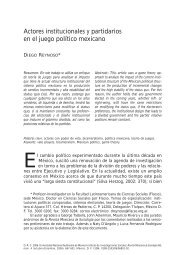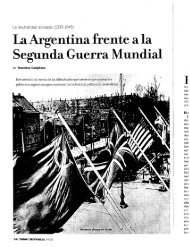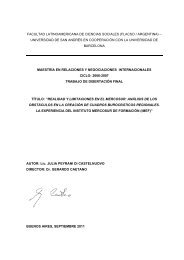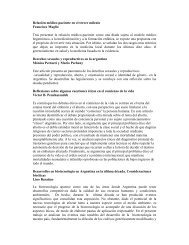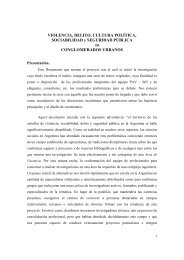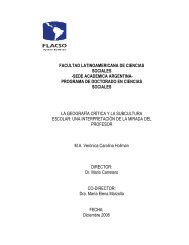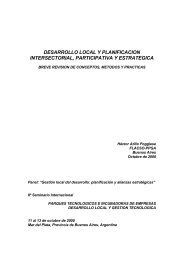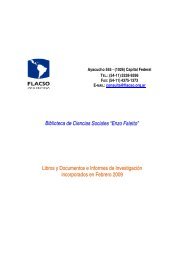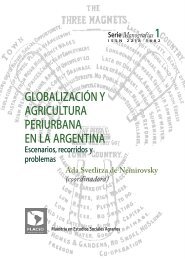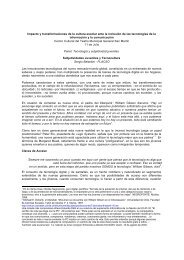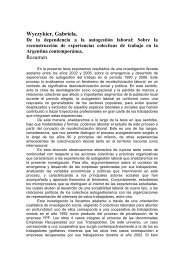Mercedes Botto Andrea Carla Bianculli - Flacso
Mercedes Botto Andrea Carla Bianculli - Flacso
Mercedes Botto Andrea Carla Bianculli - Flacso
Create successful ePaper yourself
Turn your PDF publications into a flip-book with our unique Google optimized e-Paper software.
the handling of the trade policy given that the final aim was to establish a common tariff. In turn,<br />
this limitation would also affect the external trade policy, which in the context of the Convertibility<br />
Plan was the only area where economic policy could be implemented. In this sense, the pressure<br />
exercised by the Unión Industrial Argentina (UIA/Argentine Industrial Union) turned out to be<br />
quite functional to the Minister’s interests. On the other hand, the increasing power Cavallo had<br />
over national politics, which was based on his successful Convertibility Plan, turned out to be quite<br />
a positive signal for private sectors about the fact that the Treaty of Ouro Preto was not mature<br />
enough and that it would not be signed.<br />
Certainly, the struggle between both Ministries – Economy and Foreign Affairs – facilitated the<br />
joint and effective work done by academics and negotiators from 1991 to 1993. Unlike what had<br />
been the experience in trade policy formulation in Argentina, the private sector was not involved in<br />
the elaboration of the CET, which in turn allowed for this to be the result of technical studies based<br />
on empirical evidence, at least in terms of the Argentine negotiating team.<br />
3.2.3. UTILIZATION IN DECISIONS<br />
During the negotiation among the four governments for the establishment of the common<br />
nomenclator, other issues were brought which demanded consensus building: the agricultural, the<br />
capital goods, and the computer and telecommunications sectors. Argentina and Brazil had<br />
different and opposing positions in terms of these sectors, and these were certainly difficult to<br />
solve37. During these discussions, the studies and analyses that most helped the Argentine<br />
delegation were those produced by the joint team of experts from the Ministry of Economy and the<br />
UBA. Nevertheless, when negotiating, the national delegation showed both lack of internal<br />
coordination and political will. Negotiations come to a halt when Cavallo decided to promote a<br />
closer relationship with the United States, and the subsequent signature of a free trade agreement.<br />
Thus, the position of the Argentina negotiators and experts within the GMC became blurred.<br />
By the mid-1993, it was quite evident that the schedule settled by the Treaty of Asunción regarding<br />
the establishment of the CET – January 1, 1995 – could not be fulfilled. Even if the process of<br />
harmonization had already reached 95% of the whole tariff universe, there were still crucial debates<br />
to be solved [Berlinski et al., 2005]. It is then that Brazil decides to assume the leadership in the<br />
debate both in political and operative terms.<br />
At the operative level, Brazil managed to impose its own tariff scheme since there was no major<br />
resistance from Paraguay and Uruguay. Thus, the structure of the CET would be established<br />
37 In terms of the agriculture sector, Brazil intended to establish low nominal aliquots, an idea that Argentina<br />
refused since it feared that the establishment of lower tariffs for products such as powder milk, wheat, meat<br />
or rice, would hinder the entrance of Argentine products to the Brazilian market when competing with the<br />
subsidized prices of third countries. In the case of capital goods, Argentina wanted to place this sector in one<br />
of the lowest levels of protection since this would allow upgrading equipment and processing and product<br />
technologies, through the acquisition of cheaper equipments and technologies in the international market.<br />
However, Brazil rejected the proposal. Finally, and as far as the computer and telecommunications goods<br />
were concerned, Brazil was determined to establish high tariffs, remaining thus as the exclusive supplier in the<br />
region [Giorgi et al., 2003].<br />
30



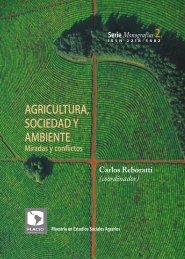
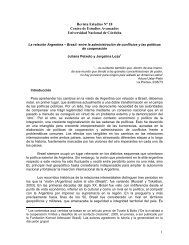
![[P] Disertacion.Melisa.Galvano.pdf - Flacso](https://img.yumpu.com/14596629/1/184x260/p-disertacionmelisagalvanopdf-flacso.jpg?quality=85)
